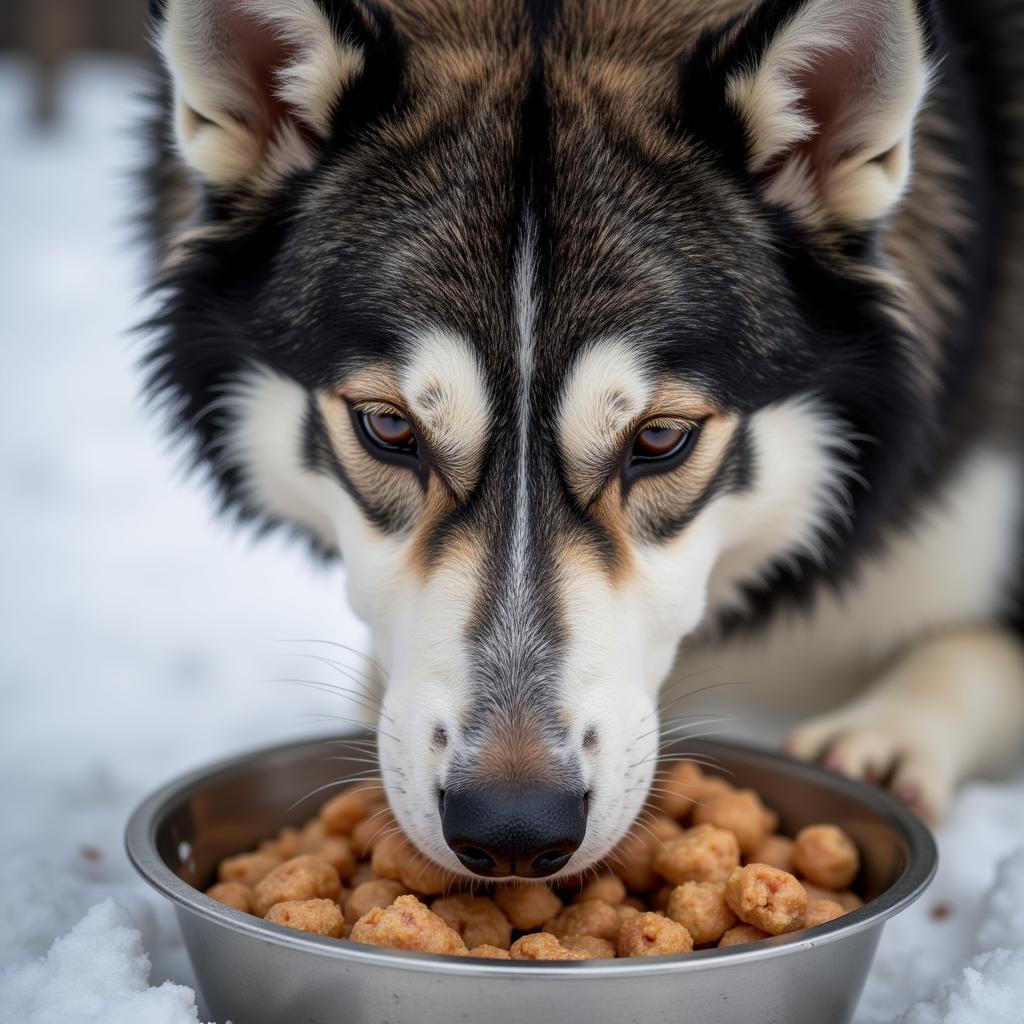Dog sledding is a demanding sport that requires dogs to be in peak physical condition. A crucial aspect of maintaining their health and performance lies in providing them with the right nutrition. Choosing the best Dog Food For Sled Dogs can be overwhelming, but this guide will equip you with the knowledge to make informed decisions about your furry athletes’ dietary needs.
Understanding the Unique Needs of Sled Dogs
Sled dogs are incredible athletes that endure extreme conditions. Their energy expenditure during races or training sessions far surpasses that of an average dog. This is why understanding their unique dietary requirements is essential.
High Energy Demands: Fueling the Engine
Sled dogs burn an astounding amount of calories, especially during competitions. Their diet must be rich in high-quality fats and carbohydrates to replenish their energy reserves and support sustained performance.
Protein Powerhouse: Building and Repairing Muscle
Intense physical activity takes a toll on muscles. Sled dogs need a diet rich in easily digestible protein to aid in muscle recovery, repair, and growth. This ensures their bodies can handle the physical demands placed upon them.
Essential Fatty Acids: Maintaining Peak Condition
Omega-3 and Omega-6 fatty acids are crucial for maintaining a healthy coat, reducing inflammation, and supporting joint health in sled dogs. These essential fats contribute to their overall well-being and longevity.
 A sled dog eating food from a bowl
A sled dog eating food from a bowl
Choosing the Right Dog Food for Sled Dogs
When selecting dog food for sled dogs, consider the following factors:
1. High Calorie Content:
Look for foods with a minimum of 400-500 calories per cup, or even higher depending on your dog’s activity level.
2. High-Quality Protein Sources:
Choose foods with meat-based protein sources listed as the first few ingredients. Chicken, fish, lamb, and beef are excellent options.
3. Healthy Fat Sources:
Opt for foods that include healthy fats like chicken fat, fish oil, and flaxseed oil.
4. Limited Fillers:
Avoid foods with excessive fillers like corn, wheat, and soy, as they offer minimal nutritional value.
5. Added Supplements:
Consider foods fortified with glucosamine and chondroitin for joint support, as well as probiotics for digestive health.
Feeding Strategies for Sled Dogs
1. Adjust Food Intake Based on Activity Level:
Increase food portions during periods of intense training or racing and reduce them during rest days.
2. Multiple Meals:
Divide your sled dog’s daily food ration into multiple smaller meals to aid digestion and maintain energy levels.
3. Hydration is Key:
Always provide access to fresh, clean water, especially after exercise.
4. Monitor Body Condition:
Regularly assess your dog’s body condition to ensure they are maintaining a healthy weight.
Common Questions about Dog Food for Sled Dogs
1. Can I feed my sled dog a raw diet?
Raw diets can be suitable for sled dogs, but it’s crucial to consult with a veterinarian experienced in canine nutrition to ensure nutritional balance.
2. How much food should I feed my sled dog puppy?
Sled dog puppies have different nutritional needs than adults. Consult with your veterinarian for breed-specific feeding guidelines.
3. What are the signs of nutritional deficiencies in sled dogs?
Signs of nutritional deficiencies can include weight loss, poor coat condition, lethargy, and decreased performance.
Conclusion: Fueling Champions
Providing your sled dog with the right nutrition is an investment in their health, performance, and overall well-being. By understanding their unique needs and following these guidelines, you can ensure your furry athletes have the fuel they need to thrive on the trails.
Remember, always consult with your veterinarian to determine the best dietary plan for your sled dog based on their individual needs and activity level.
FAQ
-
What is the best type of fat for sled dogs? Chicken fat, fish oil, and flaxseed oil are excellent sources of healthy fats for sled dogs.
-
Can I give my sled dog supplements? Yes, supplements like glucosamine, chondroitin, and probiotics can be beneficial for sled dogs. Consult with your vet before adding any supplements.
-
How often should I feed my sled dog? Divide their daily food ration into multiple smaller meals throughout the day.
-
What should I do if my sled dog is losing weight? Consult your veterinarian to rule out any underlying health conditions and adjust their diet accordingly.
-
Can I make my own sled dog food? While it’s possible, it’s crucial to consult with a veterinary nutritionist to ensure the diet is balanced and meets all of your dog’s nutritional requirements.
-
What are some common mistakes to avoid when feeding a sled dog? Overfeeding, underfeeding, not providing enough water, and not adjusting food intake based on activity levels are common mistakes.
-
Are there any specific brands of dog food recommended for sled dogs? Consult with your veterinarian for recommendations tailored to your dog’s individual needs and dietary preferences.
Need More Help?
For any further assistance or guidance regarding your sled dog’s nutritional needs, please don’t hesitate to contact us!
Phone: 02437655121
Email: minacones@gmail.com
Address: 3PGH+8R9, ĐT70A, thôn Trung, Bắc Từ Liêm, Hà Nội, Việt Nam.
Our dedicated customer support team is available 24/7 to answer your questions and provide expert advice.